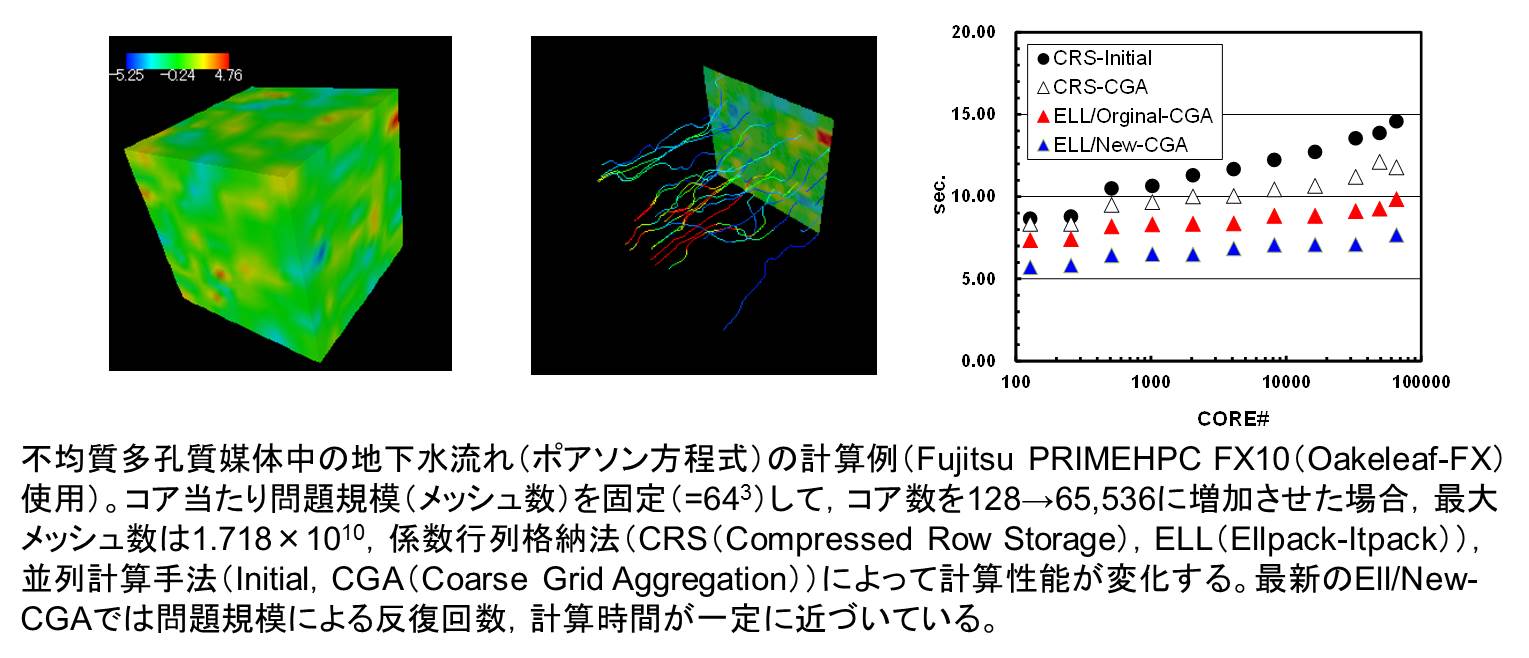Numerical Analysis and Computational Science (in Applied Mathematics and Mathematical Engineering)
Modern challenging issues in science and engineering cannot be solved in closed form or by hand, and should count on computers. Numerical analysis is an academic area where we consider how such treatments can be done, and whether they can be mathematically justified. It concerns applications (physics, biology, finance and so on), mathematics (analysis, algebra, geometry, …), and knowledge on computers (programming, parallelization, …), and thus interested people can join in various different ways. Numerical analysis has extremely long history since Euler and Gauss, and accordingly has huge literature; but since numerical analysis is such a diverging academic area, it still can have interesting new topics, possibly (and often) somehow overlooked. Thus in numerical analysis enthusiastic young researchers can easily achieve intriguing original works still in this 21st century, if blessed with a good new idea.
When we are more interested in specific applications and regard numerical analysis as its base, the area is often called “computational science.” Computational science is a style of science, often called “the 3rd science,” following experimental science (the 1st science) and theoretical science (the 2nd.) There people challenge impeding problems that are hard to understand analytically by hand, and/or experimentally by physical equipment and rooms, rather by carrying out the so-called simulations to get new insights. Our laboratory also aims at such studies.
Now, as of writing this page, the world is gradually moving on to the 4th science, the so-called “data-driven science” (the new research style based on huge real data and statistical and machine-learning methods) beyond the 3rd science. Even in this new era, still people should count on computers and numerical computations to keep going on, and thus numerical analysis is still the basic indispensable tool. In this sense, we the 3rd laboratory members are also obliged to establish basic numerical methods for the 4th science activities, and vice versa to incorporate the sense of the 4th science into numerical analysis to update the historical academic area.
Below we list some typical research topic in our laboratory.
Structure-Preserving Numerical Methods
 “Structure-preserving numerical methods” are such methods which are specially designed based on not only the target mathematical equations but also their physical backgrounds (and their associated abstract mathematical structures); in this way, we can often obtain powerful numerical algorithms that significantly beat classical, standard ones.
“Structure-preserving numerical methods” are such methods which are specially designed based on not only the target mathematical equations but also their physical backgrounds (and their associated abstract mathematical structures); in this way, we can often obtain powerful numerical algorithms that significantly beat classical, standard ones.
Problems in physics, chemistry, biology, or other modern areas including finance, are often modeled as differential equations, and their numerical computations concern how we discritize (approximate in finite dimensions) them and how we implement them on computers. It has been studied in various ways since the time of Euler and Gauss (i.e., even far before “computers” were invented!), but the studies basically focused only on how we discretize the equations themselves. In the 1990’s, some people had noticed that sometimes stepping further into the background physical (chemical, …) problems and considering how we treat the problem numerically could yield better numerical results (in view of the original problem, of course). There, mathematically speaking, we often well respect some abstract mathematical structure (quite often some geometrical structure) in the mathematical model, which is deeply connected to the original physics (chemistry, …), we call such style and methods “structure-preserving numerical methods” (or “geometric numerical integrations”). In the 21st century, it became one of the most important topic in numerical analysis. Our laboratory has developed a powerful structure-preserving numerical method for partial differential equations since the 1990’s, and is now one of the top research groups in the world.
For more detailed information, see the homepage of Matsuo as well.
Design, Analysis, and Applications of Highly-Accurate Function Approximations

Function approximations are fundamental mathematical tool in various analytic numerical computations including numerical differentiation and integration, and approximated functional equations. It has wide variety of applications and is supported by deep mathematical theories.
Functions belong to infinite-dimensional spaces in general, and it is not always obvious how we should reduce them to finite-dimensional ones fitting to computers. Function approximations have been considered on top of a certain classification of target functions, where adequate methods have been devised for each class; we are still keeping this effort, replying to the new demands in modern science and engineering. They in turn provides progresses in numerical integration methods and approximation of functional equations.
One typical method continuously investigated in our laboratory is the so-called “Sinc method,” which is a generic term for numerical methods based on the sinc function (sin(x)/x). It is extremely suited to the approximation of analytic functions. It is also well utilized with the “double-exponential transformations” (devised by Takahasi and Mori), where the combination is often abbreviated as the “DE-Sinc methods;” the combined methods are often quite powerful for, for example, differential and integral equations. The classical “double-exponential formulas”(also by Takahasi and Mori), which had been devised for numerical integrations prior to the DE-Sinc method, is a highly-accurate and powerful tool, closely related to our current interest. In these methods, a deep mathematical theory has been given to show that they are “nearly-optimal” under a certain setting of functional spaces.
Recently we have been moving on to a new style of designing formulae/methods, where we are still based on the optimality in a certain function space, but more aggressively employ mathematical optimizations to further enhance possibility. We already have some successful observations, and are going to extend them to more general frameworks.
For more detailed information, see the homepage of Tanaka as well.
Multigrid method

Numerical simulations based on finite-element or finite-difference methods finally reduce to the solution of large linear systems with sparse coefficient matrices.
There are various methods for solving linear systems, while the most typical class of solution methods is the class of iterative methods including the famous conjugate gradient (CG) method.
Multigrid (MG) method is one of such iterative methods, whose most striking advantage is that it is “scalable”(in the sense that the number of the required iteration does not depend on the size of the target problem), which comes true thanks to the mathematical feature of MG that it suppresses errors at different frequencies simultaneously. The MGCG method, which is a CG method incorporated with MG as its preconditioner, is extremely useful as a parallel method for large scale problems.
We are also developing other algorithms with various complex problems.
For more detailed information, see the homepage of Nakajima as well.

